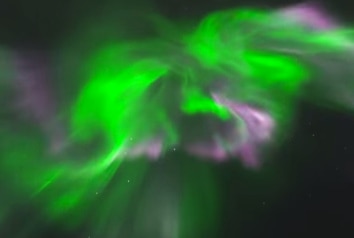Create a free profile to get unlimited access to exclusive videos, sweepstakes, and more!
Polar Lights in Real Time

I’ve written a few times* about how the aurorae—the northern (and southern) lights—aren’t just static or slow-moving displays but can positively flash and flap in real time, moving in waves that take less than a second to explode across the sky.
Still, every time I see a real-time video of them, I’m astounded. Science isn’t magic, but it can be magical. From “skydivephil” comes such a video, but it has some extras. It’s lovely and fun for about the first 1:51, but then prepare to have your brain saturated at the 1:51 mark.
How cool is that? Did you also see the meteors at 0:19 and at the very end? Cool. The polar bear was a nice touch too. That’s a hazard to aurora watching I hadn’t considered.
But that moment at 1:52 when the music turns up, and so does the camera … that display is called a corona. The aurorae are due to subatomic particles from the Sun’s solar wind getting funneled into our atmosphere by the Earth’s magnetic field. The air gets energized and glows in characteristic colors due to oxygen and nitrogen atoms and molecules.
The particles sweep down in sheets, and when seen from the side can look long and thin. But if you’re directly underneath them, you get that amazing perspective effect of the corona, looking straight up into the vertical sheets. They appear paper thin, curling and whipping, moving in graceful and mesmerizing patterns, apparently radiating away from the sky’s zenith. And it all happens so quickly, like someone throwing a bucket of neon paint into the sky!
Every time I see video like this I vow to get somewhere north to see an aurora. Despite all the time I spend looking up at night, I’ve never seen one. That has to change.
Seeing a polar bear—from a distance—would be pretty cool, too.
*See “Soaring: Lights Over Norway”, “INCREDIBLE Footage of an Aurora Dancing in Real Time!,” and “Real Time Footage of Aurora Shows Them Dancing and Shimmering”.


























